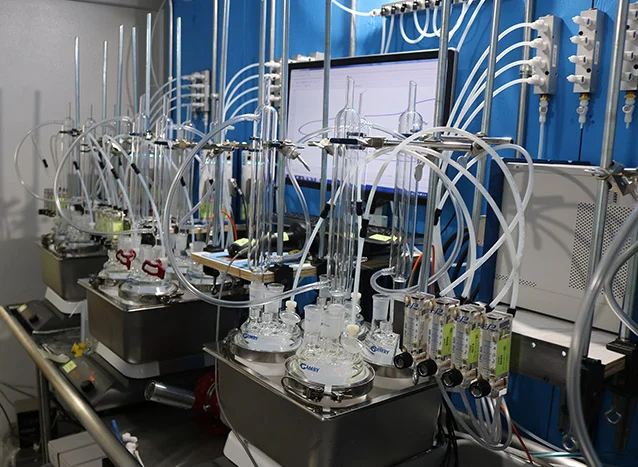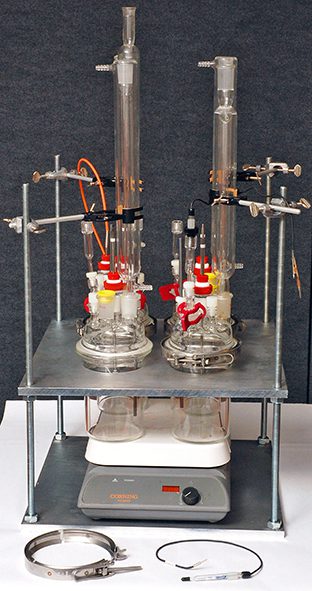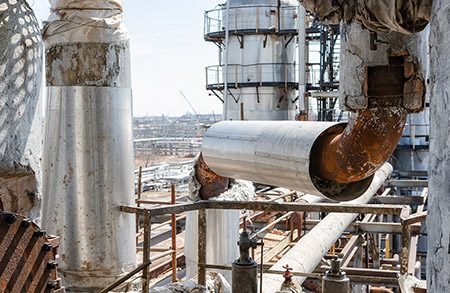Electrochemical Corrosion Testing
ELECTROCHEMICAL CORROSION TESTING
Electrochemical corrosion testing is a technique used to evaluate the corrosion resistance of a metal or alloy by measuring its electrochemical behavior in a corrosive environment. It involves exposing a test specimen to a corrosive solution while monitoring its electrochemical activity. This is typically done by immersing the specimen in a solution and measuring the potential and current flow between the specimen and an electrode (reference electrode) placed in the same solution.
Testing is performed through a controlled electrochemical reaction between two materials, or between an exposed surface and its surrounding environment. The introduction of a voltage current to the testing setup rapidly accelerates the effect of the test solution on the material. Therefore, targeted electrolyte solutions can be used to simulate long-term conditions and predict and characterize the corrosive properties of metal materials and components.
ELECTROCHEMICAL CORROSION APPLICATIONS
Analysis of Medical Devices: determine crevice corrosion susceptibility
Comparison of Raw Materials: screen for corrosion characteristics
Evaluate Effects: investigate passivation or surface modifications of corrosive behavior
Measure Processing Effects: evaluate and compare corrosion properties
Evaluate Bimetal Combinations: examine for galvanic corrosion behavior
ELECTROCHEMICAL CORROSION TESTING METHODS
Cyclic Potentiodynamic Polarization Measurements (ASTM F2129)
- Used to determine the corrosion behavior of a metal or alloy in a solution. It involves scanning the potential of the working electrode over a range of potentials and back to the starting potential at a constant scan rate while measuring the resulting current. The resulting data can be used to identify the corrosion potential, corrosion current density, and passivation potential of the material. The polarization curves obtained from the test can also provide information about the kinetics of the corrosion reaction and the corrosion rate of the metal. CPP is particularly useful for studying localized corrosion phenomena such as pitting and stress corrosion cracking.
Corrosion Susceptibility of Iron, Nickel, Cobalt Alloys (G61)
- The test involves measuring the potential of the metal or alloy specimen in a corrosive solution at various intervals over a period of time. It is performed by immersing a specimen of the alloy to be tested in a solution containing a specified concentration of sulfuric acid and ferric sulfate. The potential of the specimen is then measured at regular intervals over a period of time, typically 24 to 72 hours. The measured potential values are used to calculate the corrosion rate of the alloy. The G61 test is useful for evaluating the corrosion resistance of alloys under conditions that simulate those encountered in industrial environments, particularly those involving sulfuric acid solutions. The test is often used to determine the susceptibility of alloys to intergranular corrosion, pitting corrosion, and stress corrosion cracking. The G61 test is widely used in the aerospace, chemical processing, and oil and gas industries to evaluate the corrosion resistance of alloys in applications where they are exposed to corrosive environments. The test can also be used to evaluate the effectiveness of corrosion inhibitors and other treatments in preventing the corrosion of these alloys.
Galvanic Corrosion (ASTMG71)
- In this test, two metal specimens are placed in contact, typically in a holder that maintains contact between the two metals. The specimens are then immersed in an electrolyte solution, and the corrosion rate of the anode is measured by monitoring the weight loss of the specimen or by using electrochemical techniques such as potentiodynamic polarization or electrochemical impedance spectroscopy. The test can be used to evaluate the relative galvanic corrosion resistance of different metal combinations and to determine the effect of environmental factors, such as temperature and pH, on galvanic corrosion rates. The test can also evaluate the effectiveness of coatings or other treatments in reducing galvanic corrosion between dissimilar metals.
Galvanic Corrosion of Medical Implants (F3044)
- F3044 is an ASTM test method to evaluate the galvanic corrosion of metallic medical implants in contact with other metallic components in the body. The test simulates the physiological conditions in the body and assesses the potential for corrosion-induced failures of medical implants. Galvanic corrosion occurs when dissimilar metals in the body create an electrochemical cell, leading to accelerated corrosion of one metal. F3044 involves immersing the implant in simulated body fluid and measuring the electrical potential between implanted metal components to calculate the galvanic current and corrosion rate. It's important to ensure medical implants are corrosion-resistant to prevent complications.
Linear Polarization Resistance (ASTM G59)
- LPR is a non-destructive technique used to measure the corrosion rate of metallic materials. The LPR method is based on measuring the polarization resistance of a metal surface in a corrosive environment. In LPR testing, a small potential (voltage) is applied to a metal specimen in a corrosive solution, and the resulting current is measured. By analyzing the current response of the metal, the LPR technique can determine the polarization resistance, which is proportional to the corrosion rate of the material. The LPR method is a rapid and reliable technique that can be used to evaluate the corrosion resistance of various metallic materials in a variety of environments, including aqueous solutions, seawater, and various industrial process fluids. It can also be used to evaluate the effectiveness of corrosion inhibitors and coatings. The LPR test method is widely used in industries such as aerospace, automotive, and oil and gas, where corrosion resistance is critical for component performance and reliability. It is also used in the evaluation and selection of metallic materials for use in construction, infrastructure, and other applications where corrosion resistance is a concern.



Dezincification Testing
Electrochemical Corrosion Testing
Environmental Stress Cracking (ESC)
Formicary (Ant’s Nest) Corrosion Evaluation
Heat & Fluid Aging
Mercurous Nitrate Testing
Passivation Testing of Medical Components
Potentiodynamic Corrosion
Residual and Assembly Stress Testing of Copper Alloys
Sensitization Testing
Stress Corrosion Cracking (SCC)
ELECTROCHEMICAL CORROSION FAQ
Electrochemical corrosion testing is a technique used to evaluate the corrosion resistance of metallic materials in a given environment. The technique involves measuring the electrochemical properties of the material to determine its susceptibility to corrosion.
There are various types of electrochemical corrosion testing methods, including linear polarization resistance (LPR), cyclic potentiodynamic polarization (CPP), galvanic corrosion testing, critical pitting temperature (CPT) testing, and others.
Electrochemical corrosion testing provides a rapid, non-destructive, and accurate method for evaluating the corrosion resistance of metallic materials. It is also highly reproducible, allowing for consistent and reliable results.
Electrochemical corrosion testing can be used to evaluate the corrosion resistance of a wide range of metallic materials, including alloys, steels, and non-ferrous metals.
The corrosion rate of a material is affected by factors such as the chemical composition of the material, the nature of the environment (e.g., pH, temperature, humidity), and the presence of other substances (e.g., impurities, dissolved gasses).
The duration of electrochemical corrosion testing varies depending on the specific test method and the material being tested. Some tests may take a few hours, while others may take several weeks or months.
ELECTROCHEMICAL CORROSION ASTM TESTING METHODS
- ASTM G59: Standard Test Method for Conducting Potentiodynamic Polarization Resistance Measurements
- ASTM G85: Standard Practice for Modified Salt Spray (Fog) Testing
- ASTM G59: Standard Test Method for Conducting Cyclic Potentiodynamic Polarization Measurements for Localized Corrosion Susceptibility of Iron, Nickel, or Cobalt-based Alloys
- ASTM G69: Standard Test Method for Measurement of Corrosion Potentials of Aluminum Alloys
- ASTM G71: Standard Guide for Conducting and Evaluating Galvanic Corrosion Tests in Electrolytes
- ASTM G150: Standard Test Method for Electrochemical Critical Pitting Temperature Testing of Stainless Steels and Related Alloys
RELEVANT ACCREDITATIONS
Click here for a complete list of accreditations and certifications for all IMR Test Labs locations.


